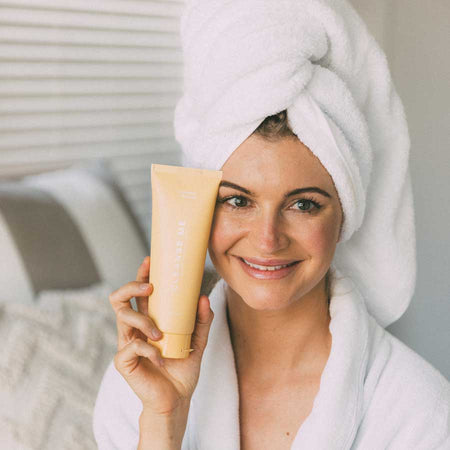What Does Moisturiser Do And How Can I Choose A Good One?

Moisturiser is a key component of any skincare routine.
You will have heard that line a thousand times, are we right?
But, what does a good moisturiser actually do?
They moisturise your skin… duh! That part is fairly obvious, being implied in the name of the product!
Moisturisers actually do a whole bunch of other stuff, apart from the stock standard moisturising aspects.
So, let’s explore what they can do for your skin and how to ensure you are using one that your skin is going to respond to.
What Is A Moisturiser?
Put simply, a moisturiser is a product that is specially formulated to to hydrate and protect your skin. It works by helping the outer layer of skin retain moisture, creating a barrier against environmental damage and preventing your skin from drying out.
Using expert formulations, moisturisers are designed to increase and maintain the level of water content in your skin. It is important to choose the right moisturiser for your skin type as some ingredients can negate this process for you. Having the wrong moisturiser can be detrimental as you can’t achieve the characteristics of well-hydrated skin, which is more resilient and plump, with a healthy and glowing appearance.
The other key job a moisturiser performs is its barrier function. Moisturisers form a protective layer on your skin’s surface which helps to lock in moisture and shield your skin from external nasties. Many things are risky for your delicate skin - UV rays, wind, rain and other weather conditions, along with pollution and other irritants. Having that barrier minimises the risk factor.
What’s In A Moisturiser?
Every good moisturiser will contain four key components:
Humectants
These are the ingredients that keep the skin hydrated and soft, as they draw water from the deeper layers of the skin to the surface. In humid conditions, they can also draw moisture from the environment around them.
Common humectants are glycerin, sorbitol and alpha-hydroxy acids derived from foods like citrus, sugar cane and apples.
Occlusives
Occlusive ingredients help create a physical barrier on the skin which prevents loss of water by slowing evaporation. These are the ingredients that can make a moisturiser feel greasy.
Common occlusives are beeswax, mineral oil and lanolin-based ingredients.
Emollients
Emollients keep your skin looking soft and supple. They are the ingredients that smooth and soften, they also help to reduce the appearance of fine lines and wrinkles by filling the gaps between your skin cells. Made of oils and fatty compounds, you might have heard emollients referred to as lipids.
Common emollients are ingredients like shea butter, fatty acids and plant oils.
Vitamins and Antioxidants
Various kinds of vitamins and antioxidants get the good stuff into your skin, providing all the bonus benefits. These are the ingredients that offer protection from things like free radicals (that’s code for protection against premature ageing), promote skin repair and reduce skin cell damage.
Common inclusions are Vitamins C and E, green tea extract and hyaluronic acid.
How Does A Moisturiser Work?
Now that we’ve got technical about the different components that make up a good moisturiser, let’s explore how those four things combine to give you lovely soft skin and that gorgeous summer glow.
Hydration
When applied to your skin, the humectants in your moisturiser attract and bind water from the environment and the deeper layers of the skin. This increases the water content in the outermost layer, leaving your skin hydrated and fresh.
Smoothing and Softening
Once the hydration is underway, the emollients in your moisturiser get to work. They help to fill the spaces between your skin cells which may be in the process of shedding and reforming. Smoothing out any roughness or flakiness created during this process, emollients make your skin feel softer and more supple.
Protection
Once your skin is hydrated and looking great, it’s time to lock all that goodness in with a barrier of protection - this is provided by the occlusives. They form a seal over your skin, preventing water loss and protecting it from the external elements and any irritants. This element is particularly important in harsh weather conditions or if you suffer from dry skin.
Choosing The Right Moisturiser
Now that you are a bit of an expert on moisturisers, it’s time to choose the right one for you. These are some of the things you should think about when selecting:
- Skin Type: Consider how your skin will react, if it is prone to dryness, choose a moisturiser with a rich formulation, and strong emollients and occusives. If you are more prone to breakouts, choose a light, everyday option. If you are looking to plump, hydrate and tighten your skin choose something formulated to these needs.
- Ingredients: Natural ingredients are often a better choice for your skin as they give all the goodness Mother Nature intended.
- Additives: Some ingredients can actually pull moisture out and irritate your skin. Avoid harmful additives like parabens, sulphates and synthetic fragrances.
- Weather: Consider the climate when selecting your moisturiser. For humid weather, a lighter formulation is recommended, but when the seasons change, a more emollient-rich moisturiser can combat dryness and loss of hydration.
Not sure what you need? Then check out our range of natural skincare products online now, or message one of our friendly team and we will be more than happy to help.

